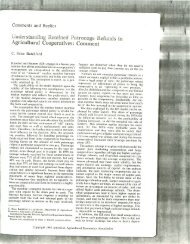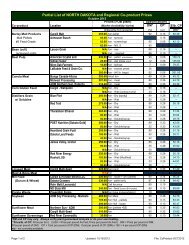Sunflower Production Field Guide - Your "Home Page"
Sunflower Production Field Guide - Your "Home Page"
Sunflower Production Field Guide - Your "Home Page"
You also want an ePaper? Increase the reach of your titles
YUMPU automatically turns print PDFs into web optimized ePapers that Google loves.
34<br />
pumpkin. Palestriped fl ea beetles are considered an<br />
important pest of commercially grown vegetables in<br />
some areas of the U.S. Recently, palestriped fl ea beetles<br />
have been observed delaying regrowth of alfalfa<br />
and also were observed feeding on soybean seedlings<br />
in eastern South Dakota.<br />
Damage: Palestriped fl ea beetles chew on the cotyledons,<br />
leaves and hypocotyls of sunfl ower seedlings,<br />
causing them to wilt and die. Injured leaves become<br />
riddled with holes, giving them a “lacey” appearance<br />
(Figure 29). The sunfl ower plant is most sensitive to<br />
palestriped fl ea beetle injury from seedling emergence<br />
(V-E) through the four-leaf stage (V-4). Signifi cant<br />
stand losses may result from heavy feeding injury by<br />
the palestriped fl ea beetles.<br />
■ Figure 29. Damaged sunfl ower leaves by<br />
palestriped fl ea beetle. (Michael Catangui, SDSU)<br />
Scouting Method: Surveys may be accomplished by<br />
using yellow sticky cards placed close to the ground<br />
(Figure 30). Sampling seedlings for beetles also can<br />
aid in estimating populations and feeding injury<br />
levels. Palestriped fl ea beetles move very fast and are<br />
hard to count directly on the seedlings or catch with<br />
an insect net.<br />
Economic Threshold: Control is recommended when<br />
20 percent of the seedling stand is injured and at risk<br />
to loss due to palestriped fl ea beetle feeding. This economic<br />
threshold is a guideline based on published hail<br />
injury data that predicts potential yield loss relative to<br />
seedling stand loss.<br />
Management: Palestriped fl ea beetles are hard to<br />
control with chemical insecticides; research has shown<br />
that treatments may provide up to 75 percent control<br />
of adults.<br />
■ Figure 30. Yellow sticky trap for monitoring<br />
palestriped fl ea beetles. (Michael Catangui, SDSU)







